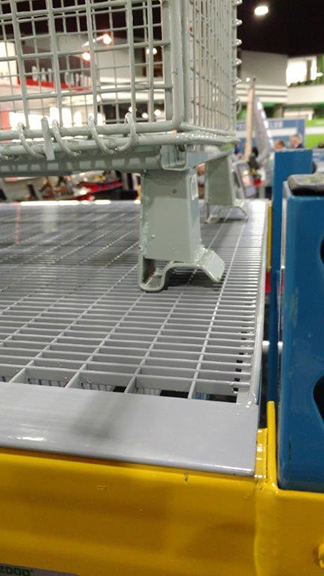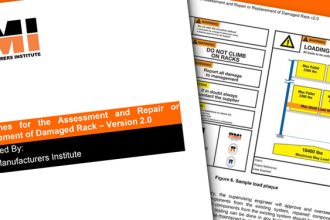How To Pick Industrial Storage Rack Decking

Decking is often part of the package when it comes to specifying and purchasing industrial steel storage racks. Getting it right is essential. That’s why the Storage Rack Decking Group, a subset of MHI’s Rack Manufacturers Institute (RMI), is available to offer insights into how to pick industrial storage rack decking.
When it comes to decking, many purchasers assume there’s neither much variety nor much to consider when selecting the equipment, explained Michael Russo, Product Development Engineer at Ohio Gratings, a member of RMI.
“People are often surprised by the many decking options, as well as by how many ways they can get it wrong,” he said. “That’s why the RMI recently issued the updated ANSI MH26.2: Design, Testing, and Utilization of Industrial Storage Rack Decking.”
Consider Load Uniformity When Picking Industrial Storage Rack Decking
 Following the ANSI MH26.2 standard can go a long way toward keeping both personnel safe and stored products undamaged. The revised standard applies to uniformly distributed loads (UDLs). It also covers a variety of more concentrated load conditions. This is a departure from the former standard, which only addressed UDLs.
Following the ANSI MH26.2 standard can go a long way toward keeping both personnel safe and stored products undamaged. The revised standard applies to uniformly distributed loads (UDLs). It also covers a variety of more concentrated load conditions. This is a departure from the former standard, which only addressed UDLs.
It’s also an important step, said Russo, because many loads stored on industrial storage rack decking fall far outside the UDL definition. He offered the following example: “You may have a four-point load in the form of a wire basket or hopper with four small feet. If you set that on a traditional deck and the feet don’t rest on reinforcing bars, the rack decking may not be adequate to support the load.”
“A UDL, on the other hand, is very straightforward,” continued Russo. “You could have 16 boxes, each at 100 pounds, spread out evenly on the deck. Or the boxes could be on a pallet that uniformly loads the deck. These different scenarios should be part of decking considerations.”
Load categories in the revised ANSI MH26.2 standard include the UDL, plus a range of other types. These include the partially distributed uniform load (PDUL), two linear loads front to back (2LLF), the four-point load (4PL), and even a nine-point load (9PL), among others.
Decking Design Variety Accommodates Multiple Load Characteristics
Because loads come in all sorts of sizes, configurations, and weights, so too does industrial storage rack decking. Among the options today are:
- Wire decks with reinforcement
- Solid metal corrugated decks
- Perforated metal corrugated decks
- Metal bar grating decks
- Metal bar solid plate-grating decks
- Composite engineered wood decks
- Perforated steel decks with reinforcement
The many available options and configurations can be confusing for the end user.
“The diversity of decking solutions makes it essential to work with a qualified racking professional,” advised Russo. “They can help you decide what the right decking is for your racks and products. They can also help establish the correct loading capacities and dimensions, plus verify that the final design is in accordance with the ANSI standard.”
Regular Inspections Further Ensure Decking Safety
It’s also the responsibility of the industrial storage rack decking’s owner to conduct regular maintenance inspections. If the rack or decking is damaged, it is essential to remove it from service and carry out the necessary repairs.
“Design your racks and decks with a team approach with your racking partner. Together, you’ll assess your decking’s use, determine the proper configuration and rating, and ensure a safe workplace,” Russo said.
Find More Storage Rack Safety Information
RMI offers a broad range of additional materials detailing best practices to enhance pallet rack safety. This includes a series of videos, presentations, publications, case studies, and frequently asked questions. Additionally, an MHI Cast podcast recording about rack safety is available.


